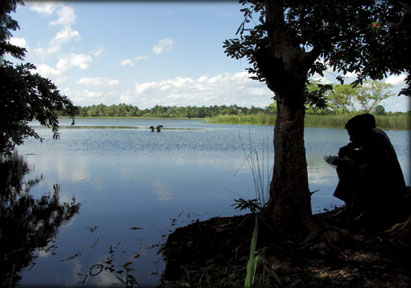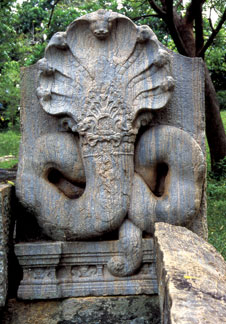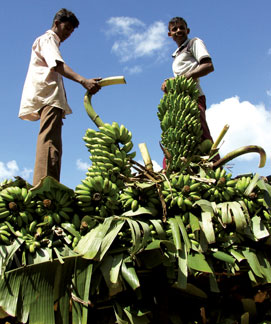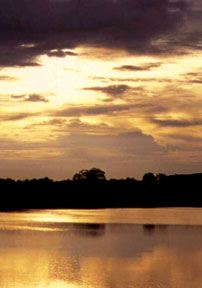Urusita Wewa, a marvel of ancient irrigation
By Mahil Wijesinghe
The cries of birds filled the morning air as I followed a narrow
tarred road through a banana cultivation. On hearing my approach, a hawk
eagle atop a tree flew into the thick vegetation and a small animal
which I couldn’t identify slithered across the road and in to the bush.
 |
|
Urusita Wewa |
I was in Mahagama, a farming hamlet in Suriyawewa that lies in the
boundary of two districts, Hambantota and Moneragala. The ancient
Urusita Wewa was situated here, against the backdrop of the lush
greenery of the banana cultivation. Villagers now call it Mahagama Wewa
because it lies in the village of Mahagama in Suriyawewa. In the past,
it had been known as Urusita Wewa.
The tank can be reached by travelling about six kilometres off
Mahagama on the Hambantota - Suriyawewa Mahagama Road. A person
travelling from Embilipitiya should go via Moraketiya on the Suriyawewa
- Embilipitiya Road.
My first visit to this area was in 2002. I came across the beautiful
Urusita Wewa while travelling to Migahajandura in the northern part of
Hambantota. Those days, driving along the same route, I encountered
muddy roads full of potholes and houses made of mud and clay on either
side.
Recently, I revisited the area and found that it had been given a new
lease of life under the mega development program of Hambantota. All the
highways and main and secondary roads in the area have been widened and
carpeted. The mud houses have been replaced by modern brick and cement
houses. The lifestyle and livelihood of the villagers have definitely
changed.
Hydraulic engineering
In ancient times, achievements in hydraulic engineering reached the
heights of advancement during the Rajarata civilisation, in the deep
South of Magama in the Tissamaharama area. The main achievement of this
civilisation was advances in hydraulic engineering which the Sinhala
engineers applied heavily in construction technologies during this
period.
Urusita Wewa is important from the point of view of the ancient
hydraulic civilisation of the Sinhala people and their marvellous
irrigation works in ancient Sri Lanka, where cobras, or nagas, were also
considered to be water spirits. Cobra engravings were heavily found in
guardstones.
Urusita Wewa is one place where the ancient valve-pit (Bisokotuwa) is
still preserved; it also has a sluice gate. A unique monolithic figure
of a cobra (Naga) with seven stone-carved hoods with a ribbon knotted
around its neck can be seen near the sluice gate of Urusita Wewa. It’s a
piece of expert stone carving, rich in great workmanship, and cannot be
found anywhere else in Sri Lanka. Archaeologists believe that this cobra
figure dates back to the Anuradhapura period in the Third Century BC. It
is an important monument which reflects the ancient hydraulic
civilisation of Sri Lanka.
 |
|
The seven-hooded cobra engraved in the
guardstone |
 |
|
A banana cultivation on
the way to the tank |
 |
|
Urusita Wewa at dawn |
Earlier, there had been two cobra figures, but there is only one now.
The other is believed to have been thrown into the Wewa. The remaining
figure and valve-pit are well preserved and are maintained by the
Mahaweli Authority of the Walawe region.
Urusita Wewa is believed to have been built in the Magama period in
Ruhuna by King Mahanaga, the brother of King Devanampiyatissa, who fled
Anuradhapura and established his own kingdom in the South.
Ancient towns
Mahagama was one of several ancient towns of that name, which were
capitals of the southern Sri Lankan principality of Rohana (Ruhuna). The
adjoining Mahanaga Vihara itself provides an array of historical
evidence and is an interesting place to visit.
Although we can’t ascertain more facts about the history of Urusita
Wewa, an interesting legend is associated with it.
During King Mahanaga’s reign, he had a royal park in Magama where he
used to spend a lot of time during holidays. One rainy day, a group of
pigs walked through this park in search of food. They destroyed all the
flowers and crops in the park. The following day, a furious park warden
searched for the culprits and found the footprints of a human being
along with those of pigs. The park warden went to inform the king about
his discovery and told the king that a shepherd had sent a group of pigs
and destroyed the royal park. The king was furious and ordered his
officers to tighten security and bring the culprit before him. So
security was tightened to catch the shepherd.
The following day, the pigs came again with the man. The watchman
pursued him. However, he ran into the forest. The next day, however, the
shepherd got caught in a trap set for him. Having his legs and hands
bound with rope, the man who resembled swine was taken to the king’s
palace. The man didn’t know how to speak.
After he was examined by doctors, the king was told that he had grown
up in the company of wild animals. The doctors told the king that if he
had been given human food, he would have been able to speak. The king
ordered his officials to train the man to get used to humans while
keeping him a prisoner. He came to be known as ‘pig-man’.
Human behaviour
After a few years, the pig-man started to behave like a human. One
day, the king asked him about the most memorable thing he had seen in
the jungle. The man replied, “Oh, King, I have seen a beautiful place
where water springs from four corners of the land and then converge in
one place”.
After inspecting the place, the king was elated and ordered his
officials to build a tank with the help of the ‘pig-man’. Before long, a
huge reservoir was built to provide water for paddy cultivation. The
king handed its ownership to the pig-man and ordered him to collect
taxes from farmers. The area became prosperous and self-sufficient and
the pig-man became rich. He came to be known as ‘Urusitana’ and his tank
became ‘Urusita Wewa’. Before long, Urusitana became a ruler of the area
and thousands of villagers became his subjects.
Owing to his cleverness, the whole province became self-sufficient.
As time passed, the king grew jealous of Urusitana. He destroyed Urusita
Wewa. Urusitana lost his mind and committed suicide. Having heard the
news, his wife also committed suicide. The Urusita Wewa was thus ruined
and the paddy fields destroyed. According to legend, this is how Urusita
Wewa got its name.
The Wewa provides a breathtaking sight in the morning. The dead trees
in the surroundings are a nestling ground for various birds such as
egrets, painted storks, spoonbills and cormorants. These birds are seen
sun-bathing on the tree tops. Freshwater fishing provides ample income
to the village folk. It is also an ideal place for bird watching,
fishing and other eco-friendly recreational activities. Just like in the
ancient times, today too, hundreds of farmers in the Walawe region have
benefited from the waters of Urusita Wewa to cultivate paddy, banana and
other crops.
Pix: Mahil Wijesinghe |


